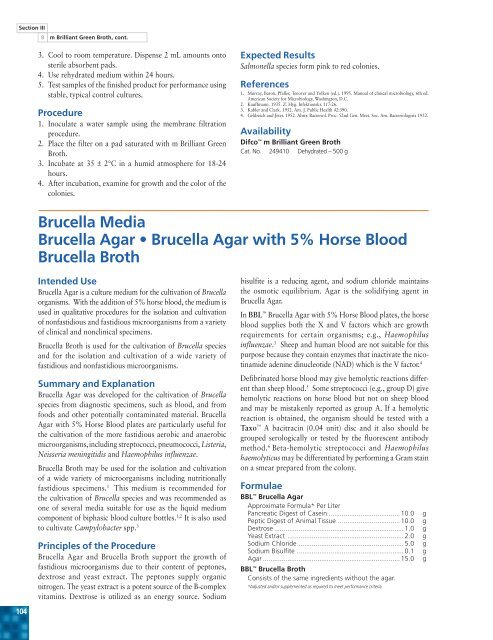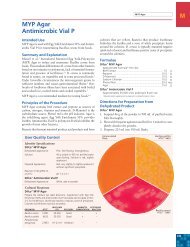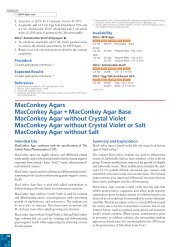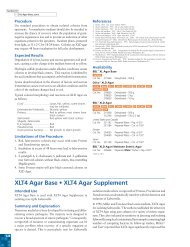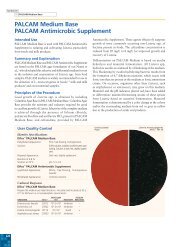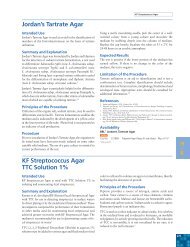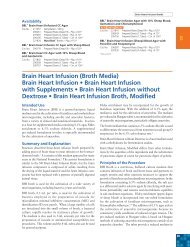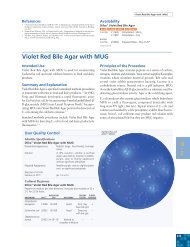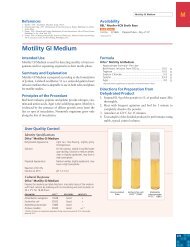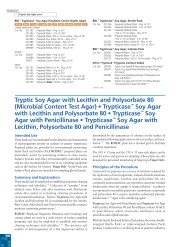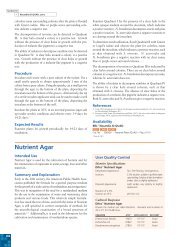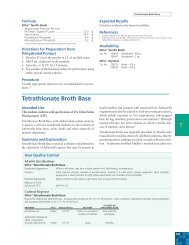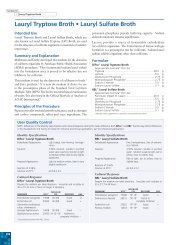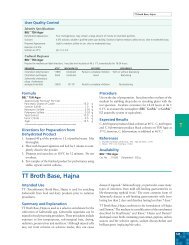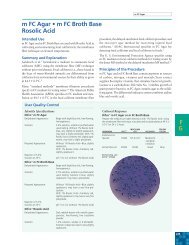Brucella Media Brucella Agar ⢠Brucella Agar with 5 ... - BVA Scientific
Brucella Media Brucella Agar ⢠Brucella Agar with 5 ... - BVA Scientific
Brucella Media Brucella Agar ⢠Brucella Agar with 5 ... - BVA Scientific
You also want an ePaper? Increase the reach of your titles
YUMPU automatically turns print PDFs into web optimized ePapers that Google loves.
Section III<br />
B<br />
m Brilliant Green Broth, cont.<br />
3. Cool to room temperature. Dispense 2 mL amounts onto<br />
sterile absorbent pads.<br />
4. Use rehydrated medium <strong>with</strong>in 24 hours.<br />
5. Test samples of the finished product for performance using<br />
stable, typical control cultures.<br />
Procedure<br />
1. Inoculate a water sample using the membrane filtration<br />
procedure.<br />
2. Place the filter on a pad saturated <strong>with</strong> m Brilliant Green<br />
Broth.<br />
3. Incubate at 35 ± 2°C in a humid atmosphere for 18-24<br />
hours.<br />
4. After incubation, examine for growth and the color of the<br />
colonies.<br />
Expected Results<br />
Salmonella species form pink to red colonies.<br />
References<br />
1. Murray, Baron, Pfaller, Tenover and Yolken (ed.). 1995. Manual of clinical microbiology, 6th ed.<br />
American Society for Microbiology, Washington, D.C.<br />
2. Kauffmann. 1935. Z. Hyg. Infektionskr. 117:26.<br />
3. Kabler and Clark. 1952. Am. J. Public Health 42:390.<br />
4. Geldreich and Jeter. 1952. Abstr. Bacteriol. Proc. 52nd Gen. Meet. Soc. Am. Bacteriologists 1952.<br />
Availability<br />
Difco m Brilliant Green Broth<br />
Cat. No. 249410 Dehydrated – 500 g<br />
<strong>Brucella</strong> <strong>Media</strong><br />
<strong>Brucella</strong> <strong>Agar</strong> • <strong>Brucella</strong> <strong>Agar</strong> <strong>with</strong> 5% Horse Blood<br />
<strong>Brucella</strong> Broth<br />
104<br />
Intended Use<br />
<strong>Brucella</strong> <strong>Agar</strong> is a culture medium for the cultivation of <strong>Brucella</strong><br />
organisms. With the addition of 5% horse blood, the medium is<br />
used in qualitative procedures for the isolation and cultivation<br />
of nonfastidious and fastidious microorganisms from a variety<br />
of clinical and nonclinical specimens.<br />
<strong>Brucella</strong> Broth is used for the cultivation of <strong>Brucella</strong> species<br />
and for the isolation and cultivation of a wide variety of<br />
fastidious and nonfastidious microorganisms.<br />
Summary and Explanation<br />
<strong>Brucella</strong> <strong>Agar</strong> was developed for the cultivation of <strong>Brucella</strong><br />
species from diagnostic specimens, such as blood, and from<br />
foods and other potentially contaminated material. <strong>Brucella</strong><br />
<strong>Agar</strong> <strong>with</strong> 5% Horse Blood plates are particularly useful for<br />
the cultivation of the more fastidious aerobic and anaerobic<br />
microorganisms,including streptococci, pneumococci, Listeria,<br />
Neisseria meningitidis and Haemophilus influenzae.<br />
<strong>Brucella</strong> Broth may be used for the isolation and cultivation<br />
of a wide variety of microorganisms including nutritionally<br />
fastidious specimens. 1 This medium is recommended for<br />
the cultivation of <strong>Brucella</strong> species and was recommended as<br />
one of several media suitable for use as the liquid medium<br />
component of biphasic blood culture bottles. 1,2 It is also used<br />
to cultivate Campylobacter spp. 3<br />
Principles of the Procedure<br />
<strong>Brucella</strong> <strong>Agar</strong> and <strong>Brucella</strong> Broth support the growth of<br />
fastidious microorganisms due to their content of peptones,<br />
dextrose and yeast extract. The peptones supply organic<br />
nitrogen. The yeast extract is a potent source of the B-complex<br />
vitamins. Dextrose is utilized as an energy source. Sodium<br />
bisulfite is a reducing agent, and sodium chloride maintains<br />
the osmotic equilibrium. <strong>Agar</strong> is the solidifying agent in<br />
<strong>Brucella</strong> <strong>Agar</strong>.<br />
In BBL <strong>Brucella</strong> <strong>Agar</strong> <strong>with</strong> 5% Horse Blood plates, the horse<br />
blood supplies both the X and V factors which are growth<br />
requirements for certain organisms; e.g., Haemophilus<br />
influenzae. 3 Sheep and human blood are not suitable for this<br />
purpose because they contain enzymes that inactivate the nicotinamide<br />
adenine dinucleotide (NAD) which is the V factor. 4<br />
Defibrinated horse blood may give hemolytic reactions different<br />
than sheep blood. 5 Some streptococci (e.g., group D) give<br />
hemolytic reactions on horse blood but not on sheep blood<br />
and may be mistakenly reported as group A. If a hemolytic<br />
reaction is obtained, the organism should be tested <strong>with</strong> a<br />
Taxo A bacitracin (0.04 unit) disc and it also should be<br />
grouped serologically or tested by the fluorescent antibody<br />
method. 6 Beta-hemolytic streptococci and Haemophilus<br />
haemolyticus may be differentiated by performing a Gram stain<br />
on a smear prepared from the colony.<br />
Formulae<br />
BBL <strong>Brucella</strong> <strong>Agar</strong><br />
Approximate Formula* Per Liter<br />
Pancreatic Digest of Casein ...................................... 10.0<br />
Peptic Digest of Animal Tissue ................................. 10.0<br />
Dextrose ..................................................................... 1.0<br />
Yeast Extract .............................................................. 2.0<br />
Sodium Chloride ........................................................ 5.0<br />
Sodium Bisulfite ......................................................... 0.1<br />
<strong>Agar</strong> ......................................................................... 15.0<br />
BBL <strong>Brucella</strong> Broth<br />
Consists of the same ingredients <strong>with</strong>out the agar.<br />
*Adjusted and/or supplemented as required to meet performance criteria.<br />
g<br />
g<br />
g<br />
g<br />
g<br />
g<br />
g
<strong>Brucella</strong> <strong>Media</strong>, cont.<br />
User Quality Control<br />
Identity Specifications<br />
BBL <strong>Brucella</strong> <strong>Agar</strong><br />
Dehydrated Appearance:<br />
Fine, homogeneous, free of extraneous<br />
material.<br />
Solution:<br />
4.3% solution, soluble in purified<br />
water upon boiling. Solution is light<br />
to medium, tan to yellow, clear to<br />
slightly hazy, may contain small<br />
amount of sediment.<br />
Prepared Appearance: Light to medium, tan to yellow, clear<br />
to slightly hazy.<br />
Reaction of 4.3%<br />
Solution at 25°C: pH 7.0 ± 0.2<br />
BBL <strong>Brucella</strong> Broth<br />
Dehydrated Appearance:<br />
Fine, homogeneous, free of extraneous<br />
material.<br />
Solution:<br />
2.8% solution, soluble in purified<br />
water upon heating. Solution is pale<br />
to medium, tan to yellow, clear to<br />
slightly hazy.<br />
Prepared Appearance: Pale to medium, tan to yellow, clear<br />
to slightly hazy.<br />
Reaction of 2.8%<br />
Solution at 25°C: pH 7.0 ± 0.2<br />
Cultural Response<br />
BBL <strong>Brucella</strong> <strong>Agar</strong><br />
Prepare the medium per label directions <strong>with</strong>out (plain) and <strong>with</strong> 5%<br />
defibrinated horse blood (HB). Inoculate and incubate at 35 ± 2°C for<br />
3 days <strong>with</strong> 3-5% CO 2<br />
(incubate S. aureus <strong>with</strong>out CO 2<br />
).<br />
INOCULUM RECOVERY RECOVERY<br />
ORGANISM ATCC CFU PLAIN WITH HB<br />
<strong>Brucella</strong> abortus 11192* 10 3 -10 4 Good Good<br />
<strong>Brucella</strong> melitensis 4309* 10 3 -10 4 Good N/A<br />
<strong>Brucella</strong> suis 4314* 10 3 -10 4 Good N/A<br />
Staphylococcus aureus 25923 10 3 -10 4 Good N/A<br />
Streptococcus pneumoniae 6305 10 3 -10 4 N/A Good<br />
Streptococcus pyogenes 19615 10 3 -10 4 N/A Good<br />
*Minimally one strain of <strong>Brucella</strong> should be used for performance testing. If these strains are<br />
not available, verify performance <strong>with</strong> a known isolate.<br />
BBL <strong>Brucella</strong> Broth<br />
Prepare the medium per label directions. Inoculate and incubate at<br />
35 ± 2°C for 7 days <strong>with</strong> 3-5% CO 2<br />
(incubate S. pyogenes for 66-72<br />
hours <strong>with</strong>out CO 2<br />
).<br />
ORGANISM ATCC INOCULUM CFU RECOVERY<br />
<strong>Brucella</strong> abortus 11192* < 10 3 Growth<br />
<strong>Brucella</strong> melitensis 4309* < 10 3 Growth<br />
<strong>Brucella</strong> suis 4314* < 10 3 Growth<br />
Streptococcus pyogenes 19615 < 10 3 Growth<br />
*Minimally one strain of <strong>Brucella</strong> should be used for performance testing. If these strains are<br />
not available, verify performance <strong>with</strong> a known isolate.<br />
B<br />
Precautions 7<br />
1. Biosafety Level 2 practices, containment equipment and<br />
facilities are recommended for activities <strong>with</strong> clinical specimens<br />
of human or animal origin containing or potentially<br />
containing pathogenic <strong>Brucella</strong> spp.<br />
2. Biosafety Level 3 practices, containment equipment and<br />
facilities are recommended for all manipulations of cultures<br />
of the pathogenic <strong>Brucella</strong> spp. and for experimental<br />
animal studies.<br />
Directions for Preparation from<br />
Dehydrated Product<br />
1. Suspend the powder in 1 L of purified water:<br />
BBL <strong>Brucella</strong> <strong>Agar</strong> – 43 g;<br />
BBL <strong>Brucella</strong> Broth – 28 g.<br />
Mix thoroughly.<br />
2. For the agar, heat <strong>with</strong> frequent agitation and boil for<br />
1 minute to completely dissolve the powder. For the broth,<br />
heat slightly, if necessary, to obtain solution.<br />
3. Autoclave at 121°C for 15 minutes.<br />
4. For preparation of blood plates, add 5 to 10% sterile<br />
defibrinated blood to sterile agar which has been cooled to<br />
45-50°C.<br />
5. Test samples of the finished product for performance using<br />
stable, typical control cultures.<br />
Procedure<br />
<strong>Agar</strong> (<strong>with</strong>out or <strong>with</strong> added blood)<br />
Use standard procedures to obtain isolated colonies from<br />
specimens.<br />
Since many pathogens require carbon dioxide on primary<br />
isolation, incubate plates at 35 ± 2°C for 24-72 hours in an<br />
aerobic atmosphere supplemented <strong>with</strong> carbon dioxide.<br />
Broth<br />
For liquid specimens, use a sterile inoculating loop to transfer<br />
a loopful to the broth medium. Swab specimens may be<br />
inserted into the broth after the inoculation of plated media.<br />
Incubate tubes for up to 7 days at 35 ± 2°C in an aerobic atmosphere<br />
<strong>with</strong> or <strong>with</strong>out supplementation <strong>with</strong> carbon dioxide.<br />
For the preparation of biphasic blood culture bottles, aseptically<br />
add sterile <strong>Brucella</strong> Broth to a blood culture bottle containing<br />
solidified sterile <strong>Brucella</strong> <strong>Agar</strong>, <strong>with</strong> increased agar at a final<br />
concentration of 2.5%. The bottles should contain 5-10% CO 2<br />
and be vented. Blood cultures should be incubated at 35°C for<br />
up to 30 days <strong>with</strong> subcultures prepared every 4 to 5 days. 1,2<br />
Expected Results<br />
<strong>Agar</strong> (<strong>with</strong>out or <strong>with</strong> added blood)<br />
After incubation, most plates will show an area of confluent<br />
growth. Because the streaking procedure is, in effect, a<br />
“dilution” technique, diminishing numbers of microorganisms<br />
are deposited on the streaked areas. Consequently, one or more<br />
105
Section III<br />
B<br />
<strong>Brucella</strong> <strong>Media</strong>, cont.<br />
of these areas should exhibit isolated colonies of the organisms<br />
contained in the specimen. Further, growth of each<br />
organism may be semi-quantitatively scored on the basis of<br />
growth in each of the streaked areas.<br />
Broth<br />
Growth in the tubes is indicated by the presence of turbidity<br />
compared <strong>with</strong> an uninoculated control.<br />
If growth appears, cultures should be examined by Gram<br />
stain and subcultured onto appropriate media; e.g., Trypticase <br />
Soy <strong>Agar</strong> <strong>with</strong> 5% Sheep Blood and/or <strong>Brucella</strong> <strong>Agar</strong> and<br />
Chocolate II <strong>Agar</strong>, Eosin Methylene Blue <strong>Agar</strong>, Levine or<br />
MacConkey II <strong>Agar</strong>.<br />
References<br />
1. MacFaddin. 1985. <strong>Media</strong> for isolation-cultivation-identification-maintenance of medical bacteria,<br />
vol. 1. Williams & Wilkins, Baltimore, Md.<br />
2. Moyer, Holcomb and Hausler. 1991. In Balows, Hausler, Herrmann, Isenberg, and Shadomy (ed.),<br />
Manual of clinical microbiology, 5th ed. American Society for Microbiology, Washington, D.C.<br />
3. Chapin and Murray. 1999. In Murray, Baron, Pfaller, Tenover and Yolken (ed.). Manual of<br />
clinical microbiology, 7th ed. American Society for Microbiology, Washington, D.C.<br />
4. Krumweide and Kuttner. 1938. J. Exp. Med. 67:429.<br />
5. Vera and Power. 1980. In Lennette, Balows, Hausler and Truant (ed.), Manual of clinical microbiology,<br />
3rd ed. American Society for Microbiology, Washington, D.C.<br />
6. Vera. 1971. Health Lab. Sci. 8:176.<br />
7. U.S. Public Health Service, Centers for Disease Control and Prevention, and National Institutes of<br />
Health. 1999. Biosafety in microbiological and biomedical laboratories, 4th ed. HHS Publication<br />
No. (CDC) 93-8395. U.S. Government Printing Office, Washington, D.C.<br />
Availability<br />
BBL <strong>Brucella</strong> <strong>Agar</strong><br />
ISO USDA<br />
Cat. No. 211086 Dehydrated – 500 g<br />
221547 Prepared Plates <strong>with</strong> 5% Horse Blood – Pkg. of 20*<br />
221548 Prepared Plates <strong>with</strong> 5% Horse Blood –<br />
Ctn. of 100*<br />
BBL <strong>Brucella</strong> <strong>Agar</strong> <strong>with</strong> 5% Horse Blood//<br />
MacConkey II agar <strong>with</strong> MUG<br />
Cat. No. 298303 Prepared I Plate Dishes – Ctn. of 100*<br />
BBL <strong>Brucella</strong> Broth<br />
USDA<br />
Cat. No. 211088 Dehydrated – 500 g<br />
296185 Dehydrated – 5 lb (2.3 kg)<br />
*Store at 2-8°C.<br />
<strong>Brucella</strong> <strong>Media</strong> for Anaerobes<br />
<strong>Brucella</strong> <strong>Agar</strong> <strong>with</strong> 5% Sheep Blood, Hemin and<br />
Vitamin K 1 • <strong>Brucella</strong> Laked Sheep Blood <strong>Agar</strong> <strong>with</strong><br />
Kanamycin and Vancomycin (KV)<br />
Intended Use<br />
<strong>Brucella</strong> <strong>Agar</strong> <strong>with</strong> 5% Sheep Blood, Hemin and Vitamin K 1 is<br />
used for the isolation and cultivation of fastidious, obligately<br />
anaerobic microorganisms.<br />
<strong>Brucella</strong> Laked Sheep Blood <strong>Agar</strong> <strong>with</strong> Kanamycin and Vancomycin<br />
(KV) is used for the selective isolation of fastidious<br />
and slow growing, obligately anaerobic bacteria from the same<br />
specimen.<br />
Summary and Explanation<br />
The isolation of obligately anaerobic bacteria from clinical and<br />
nonclinical materials requires the use of selective, nonselective<br />
and enrichment media. 1 <strong>Brucella</strong> <strong>Agar</strong> <strong>with</strong> 5% Sheep Blood,<br />
Hemin and Vitamin K 1 is an enriched, nonselective medium<br />
for the isolation and cultivation of a wide variety of obligately<br />
anaerobic microorganisms. Nonselective media are used to<br />
isolate organisms present in low numbers and to provide an<br />
indication of the numbers and types of organisms present in<br />
the specimen or sample.<br />
Kanamycin and vancomycin are included in <strong>Brucella</strong> Laked<br />
Blood KV <strong>Agar</strong> for use in selective isolation of gram-negative<br />
anaerobes, especially Bacteroides. The combination of kanamycin<br />
and vancomycin for this purpose was first described by<br />
Finegold et al. 2 Vancomycin, however, may inhibit<br />
Porphyromonas asaccharolytica. 3<br />
Principles of the Procedure<br />
<strong>Brucella</strong> <strong>Agar</strong> supports the growth of fastidious microorganisms<br />
due to its content of peptones, dextrose and yeast extract. The<br />
sheep blood, hemin and vitamin K 1 , provide essential nutrients<br />
for certain obligate anaerobes. 4<br />
The addition of the antimicrobial agents, kanamycin and<br />
vancomycin, renders <strong>Brucella</strong> Laked Blood KV <strong>Agar</strong> selective<br />
for gram-negative microorganisms. The kanamycin inhibits<br />
protein synthesis in susceptible organisms, whereas the<br />
vancomycin inhibits gram-positive bacteria by interfering <strong>with</strong><br />
cell wall synthesis. 5 The laked blood improves pigmentation<br />
of the Prevotella melaniogenica - P. asaccharolytica group.<br />
Procedure<br />
These media should be reduced immediately prior to inoculation<br />
by placing under anaerobic conditions for 18-24 hours. 6<br />
An efficient and easy way to obtain suitable anaerobic<br />
conditions is through the use of BBL GasPak EZ anaerobic<br />
systems or an alternative system. 7<br />
106


